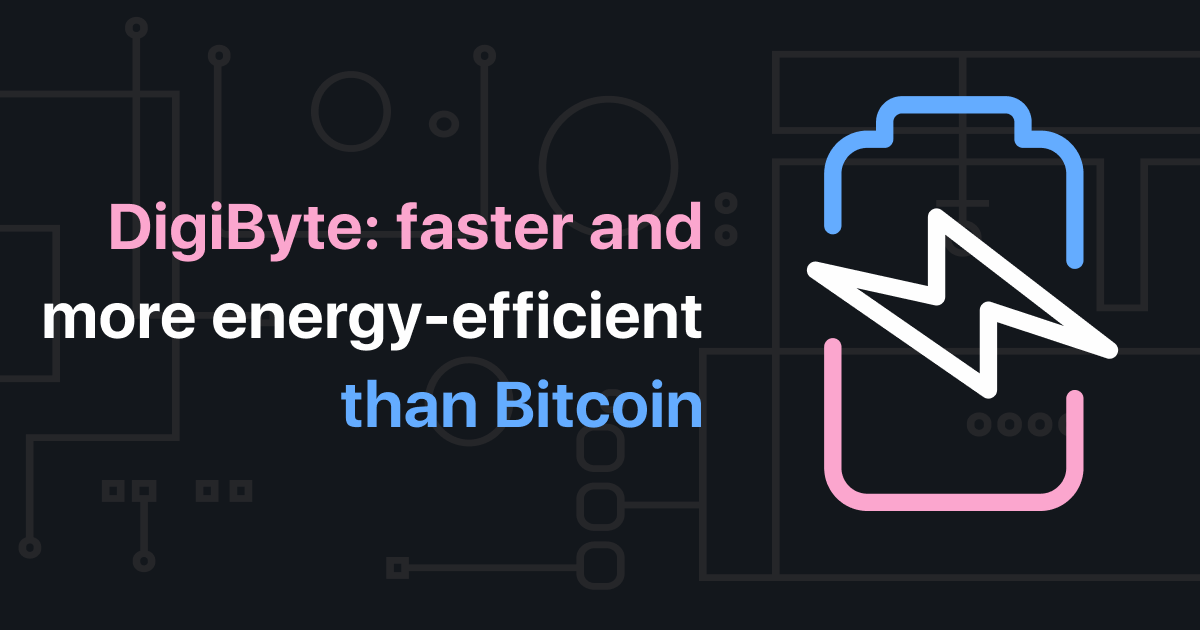DigiByte has been around for eight years and has secured itself a place in portfolios of numerous crypto investors who believe in this currency’s potential. DigiByte is truly a unique digital asset since its blockchain utilizes five mining algorithms that provide users with multiple options in terms of mining equipment. Thus, despite relying completely on the Proof-of-Work protocol, it manages to ensure sustainable use of electricity through diversity.
Key Points:
- DigiByte is one of the oldest cryptocurrencies in the market which has proven its utility over the years
- DigiByte uses a Proof-of-Work protocol and five mining algorithms which guarantee a balanced consumption of electricity, less than 1% of Bitcoins energy consumption.
- DigiByte’s energy efficiency coupled with low transaction fees and fast speed of transfers make it an ideal digital asset
- DigiByte can be accepted as payment or donation, as well as sent out as a payout
- Josiah Spackman: “How “green” is DigiByte?” (62,407,560 watts vs 50,835,199,030w (50.8 TW/h), approximately 814 times more than DigiByte, according to Josiah’s calculations)
- Read a full review: What is DigiByte
Proof-of-Work Protocol
At the core of DigiByte lies the Proof-of-Work protocol, a mechanism that possesses a legendary status in the crypto community since it was first utilized by Satoshi Nakamoto in the Bitcoin blockchain. The Proof-of-Work protocol is essential for DigiByte because its energy consumption ensures the network’s security and maintains the steady issuance of new coins, which contribute to the total supply of the currency.
DigiByte’s version of the protocol has an additional improvement in terms of protection from multi-pools. In 2014, the blockchain implemented DigiShield, a technology that ultimately allowed it to keep a 15-second block timing by recalculating block difficulty.
Five Mining Algorithms
Mining is the inalienable part of the Proof-of-Work protocol since, through it, networks are able to process transactions and sustain themselves. In the majority of blockchains, miners have only one possible way to participate in the network.
In other words, they are given only one type of mining algorithm to use. In the case of DigiByte, miners have an extensive choice of five mining algorithms. This is done to maintain diversity on the network and provide everyone with the same opportunities. People with GPUs, CPUs, FPGA, and ASICs can equally access the blockchain and start mining, thus ensuring its security.
Advantages of DigiByte
Of all possible approaches to mining, FPGA and ASICs are the most energy-efficient ones. This means that the two solutions deliver much higher performance per kilowatt-hour. Subsequently, by balancing five different mining algorithms, DigiByte maintains the optimal amount of energy consumption without any excessive usage.
Taking into consideration the fact that DigiByte is forty times faster than Bitcoin in terms of transaction speeds, it is reasonable to utilize this blockchain for daily crypto transfers. Moreover, DigiByte also has low transaction fees, which are especially minute in comparison to those of Bitcoin.
Conclusion
There are many cryptocurrencies which use the Proof-of-Work protocol, but there is no other coin like DigiByte. In seven years, DigiByte has managed to become a household name in the crypto industry and has retained its status as a lucrative digital asset.
One of the key features of DigiByte is its five mining algorithms which grant it much better security and ensure efficient use of electricity compared to other Proof-of-Work blockchains. Secure, decentralized, and sustainable are not the only qualities that are inherent to DigiByte. In comparison to Bitcoin, DigiByte can process transfers at a faster rate and has extremely low transaction fees, which make it perfect for daily use: for example, for payments.

